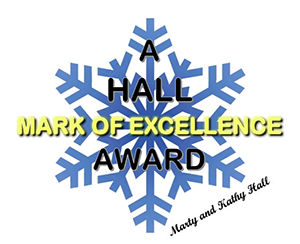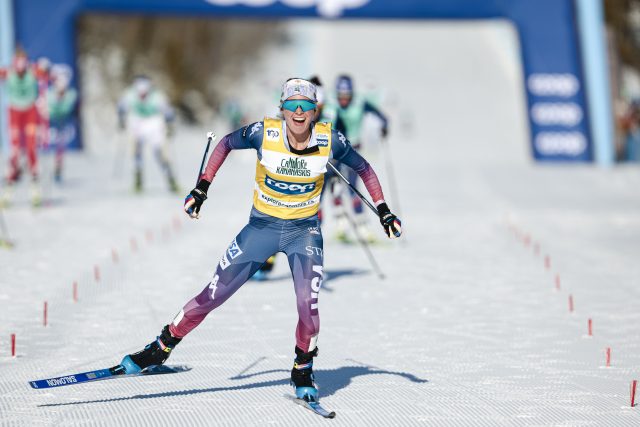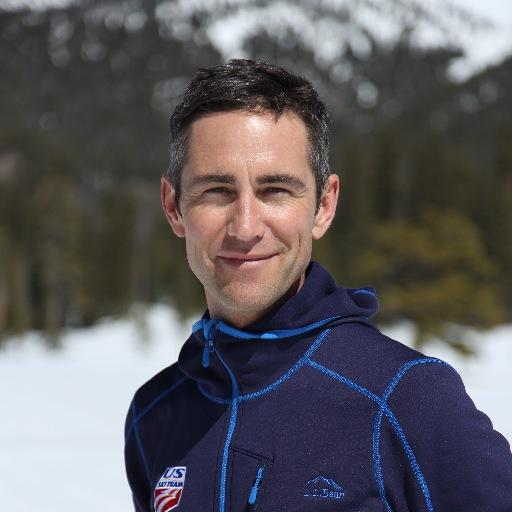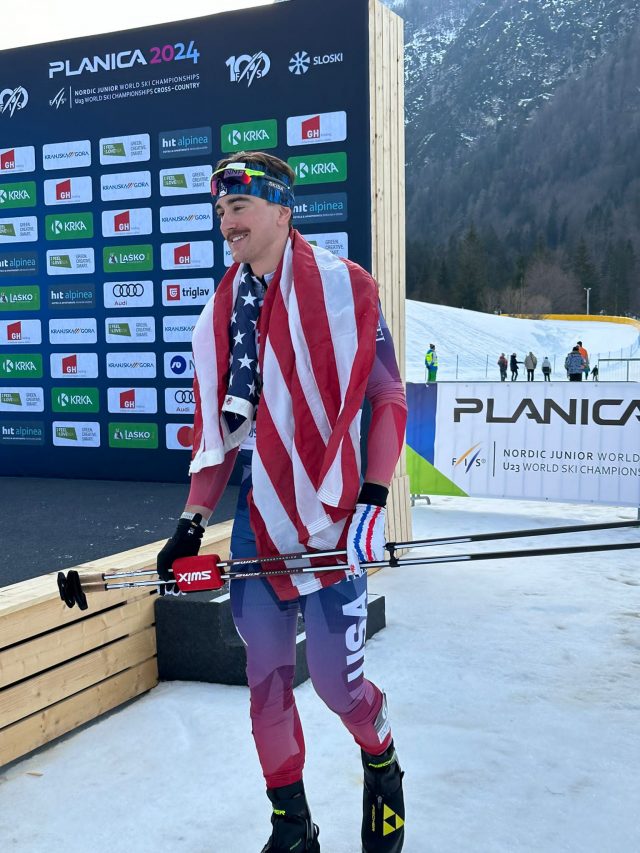 This coverage is made possible through the generous support of Marty and Kathy Hall and A Hall Mark of Excellence Award. To learn more about A Hall Mark of Excellence Award, or to learn how you can support FasterSkier’s coverage, please contact info@fasterskier.com.
This coverage is made possible through the generous support of Marty and Kathy Hall and A Hall Mark of Excellence Award. To learn more about A Hall Mark of Excellence Award, or to learn how you can support FasterSkier’s coverage, please contact info@fasterskier.com.

MINNEAPOLIS — The last time cross-country ski racing’s most elite race circuit, the World Cup, traveled to the United States from Europe, Jessie Diggins was nine years old.
At the time, in 2001, the fastest American woman on skis was Nina Kemppel, an Alaskan nearing the end of her career.
It’s hard to imagine the obstacles that athletes of Kemppel’s generation had to face.
Kemppel trained for most of her career without the support of teammates or a local club. On the World Cup, the U.S. team might have had a one- or two-man paid ski tuning staff, and sometimes, Kemppel had to wax her own skis herself.
“It was daunting,” Kemppel said by phone Friday. “But amazingly impactful, I think, in shaping my career.”
The World Cup returns to the U.S. this weekend, with a pair of races in Minneapolis. And the events mark an appropriate occasion to step back and reflect on just how far American cross-country skiing has come since the last time the circuit was here.
Let’s be honest: The sport is still on the fringes. The average resident of Manhattan or even Michigan would say, “Jessie Who?” if you asked them about the three-time Olympic medalist. But there’s almost no comparison between the U.S. Ski Team of 2001 and the squad that’s gathered to compete in the races here.
Today’s athletes travel across Europe supported by a paid crew of ski technicians who drive a converted semi trailer to work out of each race weekend.
An array of regional club teams provide groups of racers with structured training and coaching during the spring, summer and fall.
A nonprofit organization, the National Nordic Foundation, raises hundreds of thousands of dollars to subsidize expenses that elite racers rack up traveling to training camps and competitions.
And the Americans currently rank third in the International Ski Federation’s “Nations Cup”—a measure of a country’s success over the course of the season to date—behind Norway and Sweden and just ahead of Finland.
“I think when I came back to work for the U.S. Ski Team in 2006, we were 15th in the Nations Cup,” Chris Grover, U.S. cross-country program director, said recently. (The ski federation’s statistical database doesn’t reach that far back.)

“Consistency, and actually, investment—that’s really what it comes down to,” Grover added. “Gradually expanding the program, letting it be more comprehensive. The club coaches keep getting better, the clubs keep getting stronger.”
While the past few years’ Olympic medals from Diggins and Kikkan Randall have thrilled fans, perhaps the most exciting thing happening in the U.S. program today is its depth.
In the past, the Americans have had a few athletes at a time capable of mixing it up on the World Cup, or challenging for the podium. But now, there are multiple athletes of each gender who are contending for top 20s.
On the women’s side, veterans Diggins, 32, and Rosie Brennan, 35, have become regulars on the podium. Sophia Laukli, who’s just 23, won her first World Cup earlier this year, in a race up the Alpe Cermis in Italy, and she again challenged the sport’s fastest women at a race in Canada last week. Julia Kern, 26, has landed on the podium in previous years and regularly vies for the top 10 in sprinting, her strongest discipline.
On the men’s side, 24-year-old Ben Ogden was the International Ski Federation’s top-scoring young athlete last year, and had his first-ever top-three World Cup finish in December. That was weeks after another huge talent, 23-year-old JC Schoonmaker, also finished on the podium for the first time, in Sweden. Gus Schumacher, 23 and a former world junior champion, has had his own breakout season, including a fourth-place finish last month.
The list goes on. And even younger athletes than those have been scoring huge results at the junior level. No fewer than three Americans—Sammy Smith, 18, Haley Brewster, 20, and John Steel Hagenbuch, 22—notched medal-winning performances this month at the world under-23 and junior world championships in Slovenia.

“We just have so much more depth, in the women’s side and on the men’s side,” said Andy Newell, the retired U.S. sprinter who’s coaching in Minneapolis this week. “It’s a testament to the ski culture in the U.S.”
There’s still plenty of work to do. Some of the lower-ranking American athletes who competed on the World Cup in Canada last weekend had to shell out their own money, or resorted to crowdfunding, to cover some of their expenses. Innumerable children are still shut out from participating in the sport because of the steep price of equipment and limited capacity of coaching programs.
Nonetheless, this weekend’s races—expected to draw some 30,000 fans, with a strong likelihood of a Diggins podium—will be a new high water mark for the sport in America, and a reminder of the enormous progress it’s made in the past two decades.
“It’s everything, right?” Brennan said at a news conference at the Minneapolis race venue, referring to financial support, professionalism, and teamwork.
“I find myself telling some of these kids quite often what it was like back in the day. It’s truly insane, what’s happened,” Brennan said. “It’s really important to take a second and think about that. It’s something I try to do periodically, just to gain some perspective. And it allows me to have so much gratitude for all the work that everyone has put in—team staff, and support, and the community—to make something like this happen. And to make us be a team that actually has a chance of winning these races this weekend.”
Nathaniel Herz
Nat Herz is an Alaska-based journalist who moonlights for FasterSkier as an occasional reporter and podcast host. He was FasterSkier's full-time reporter in 2010 and 2011.



